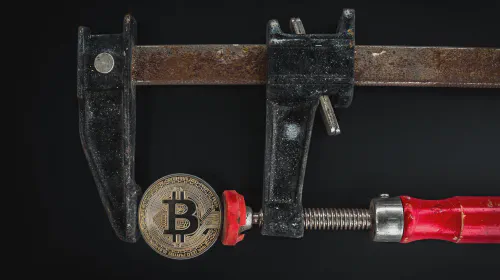Contactless Payments: The New Norm
Salomon Kisters
Jun 15, 2023This post may contain affiliate links. If you use these links to buy something we may earn a commission. Thanks!
As the world continues to evolve, so does the way we make payments. With the ongoing pandemic, contactless payments have become the new normal for many consumers. Due to safety concerns, people are opting to pay for their purchases without the need for physical contact with machines or surfaces.
This has led to an increase in the adoption of contactless payment options such as mobile payments and contactless cards. In this blog post, we will delve deeper into contactless payments, discuss their benefits and explore their impact on the future of payment methods.
The Rise of Contactless Payments
The rise of contactless payments can be attributed to several factors, the main one being the ongoing COVID-19 pandemic. Consumers are wary of touching surfaces and prefer to use payment methods that do not involve physical contact.
In addition to the pandemic, the convenience of contactless payments has also contributed to their popularity. With the increasing use of smartphones, mobile payments have become a popular choice for consumers. This has helped to increase the adoption of contactless payment methods.
The trend towards contactless payments has been observed globally, with many countries promoting the use of digital payment methods. In the UK, for example, the contactless limit for card payments was increased to £45 ($60) to encourage more people to use contactless payments.
The rise of contactless payments has also resulted in the development of new technologies such as wearable payments. Consumers can now make payments using smartwatches and other wearable devices, further enhancing the convenience of contactless payments.
Benefits of Contactless Payments
Contactless payments offer several benefits to both consumers and businesses. First and foremost, they provide added safety and security by reducing the need for physical contact and handling of cash. This is particularly important in today’s world where hygiene and cleanliness have become a top priority for everyone.
Secondly, contactless payments are fast and convenient. With just a tap of their card or smartphone, consumers can complete transactions in a matter of seconds, without the need for fumbling with cash or waiting for change.
Contactless payments are also more efficient for businesses, as they speed up the checkout process and reduce the need for cash handling and counting. This can lead to shorter queues, faster service, and improved customer satisfaction.
Moreover, contactless payments enable businesses to boost their revenue and sales, as they can accept payments from a wider range of customers who may not have access to cash or prefer not to carry it.
Also, contactless payments offer enhanced tracking and monitoring capabilities, allowing businesses to keep better records of their transactions and monitor their cash flow more effectively. This can help with accounting and financial planning and enable businesses to make informed decisions about their operations.
Differences between Contactless and Traditional Payment Methods
While contactless payments offer several benefits, they also differ significantly from traditional payment methods.
The most significant difference is the physical interaction required to complete a transaction. With traditional payment methods such as cash or card, the customer must physically hand over the payment to the merchant, who then counts and records it. In comparison, contactless payments require no physical contact, as the payment is processed through a card or smartphone without the need for any exchange of cash.
Another difference between contactless and traditional payments is the amount that can be transacted. Contactless payments are usually limited to a certain amount, usually around $30-$50. Traditional payments, on the other hand, can be used for larger transactions, such as those over $100,000.
Furthermore, traditional payments offer the option for customers to pay with a personal check, which allows them to make a payment without the need for any cash or card. Contactless payments do not offer this option, as they require a card or smartphone for payment to be processed.
Traditional payment methods such as cash and checks do not require any special hardware or software to be used. This is not the case with contactless payments, which require merchants to have a specific device that can accept contactless payments.
Security Concerns and Prevention Strategies
One of the biggest concerns surrounding contactless payments is the security of the transaction. While the lack of physical interaction provides convenience, it also creates opportunities for fraud and theft. For example, criminals can use devices to steal payment information from contactless cards when they are in close proximity to the victim’s wallet or purse.
To prevent such fraudulent activities, several measures have been implemented. For instance, most contactless payments are secured with encryption technology, which makes it difficult for unauthorized individuals to intercept and access payment information. Additionally, some contactless payment methods require customers to enter a PIN or biometric information, such as a fingerprint or facial recognition, to complete a transaction.
Another common strategy for preventing security breaches is to limit the number of contactless transactions allowed in a certain time period. Merchants can also use mobile payments which can only be approved if there is communication with the user’s phone. Furthermore, it is essential that customers regularly check their bank statements to identify any unauthorized payments.
The Future of Contactless Payments
The trend towards contactless payments is set to continue, with experts predicting that by 2025, more than half of all point-of-sale transactions worldwide will be contactless. In addition to the convenience factor, the ongoing COVID-19 pandemic has accelerated the move towards cashless and contactless payments as a safer option for customers.
The future of contactless payments is not only focused on traditional physical payments but also on emerging technologies such as wearables, mobile payments, and biometrics. Wearable technology such as smartwatches and fitness trackers can serve as payment devices, allowing customers to make payments without the need for a physical card. Mobile wallets such as Apple Pay, Google Pay, and Samsung Pay, will continue to gain popularity, providing consumers with a more seamless payment experience.
Biometrics technology is also being increasingly used in contactless payments. The use of facial recognition and fingerprint technology is becoming more widespread, making it easier and faster for consumers to authenticate payments without entering a PIN.
Yet another development in contactless payments is the integration of loyalty programs into payment methods. Consumers will be able to earn and redeem rewards in real-time, providing a seamless experience when making purchases.
Conclusion
Contactless payments are quickly becoming the new norm in the payment industry. With the ongoing COVID-19 pandemic, the demand for safe and secure payments has led to accelerated growth in contactless transactions. The convenience of contactless payments has also contributed to their popularity, eliminating the need for consumers to carry and handle physical cash or cards.
The future of contactless payments looks bright, with emerging technologies such as wearables, mobile payments, and biometrics, providing customers with more options to make payments. Mobile wallets, in particular, have gained immense popularity, making it easier for customers to manage and track their transactions in real-time.
At the same time, the integration of loyalty programs into contactless payments is transforming the payment industry, offering customers the ability to earn and redeem rewards seamlessly. Biometrics, such as facial recognition and fingerprint technology, are also increasingly used to improve security and ease of use in payment transactions.
Stay informed with the latest insights in Crypto, Blockchain, and Cyber-Security! Subscribe to our newsletter now to receive exclusive updates, expert analyses, and current developments directly to your inbox. Don't miss the opportunity to expand your knowledge and stay up-to-date.
Love what you're reading? Subscribe for top stories in Crypto, Blockchain, and Cyber-Security. Stay informed with exclusive updates.
Please note that the Content may have been generated with the Help of AI. The editorial content of OriginStamp AG does not constitute a recommendation for investment or purchase advice. In principle, an investment can also lead to a total loss. Therefore, please seek advice before making an investment decision.

DigiFinex Review 2023 - All You Need To Know
DigiFinex Review 2023 - All You Need To Know. Explore the top features, services, security measures, and earning opportunities offered by DigiFinex, a leading centralized exchange in the crypto world.

Can The Blockchain Be Hacked Or Attacked?
Blockchain technology and cryptocurrencies have seen a massive surge in popularity. Can they be hacked?

How Do Blockchain Miners Get Paid? | Explained in Detail
Learn how blockchain miners get paid by solving complex mathematical puzzles to earn cryptocurrency rewards like Bitcoin.
Protect your documents
Your gateway to unforgeable data. Imprint the authenticity of your information with our blockchain timestamp